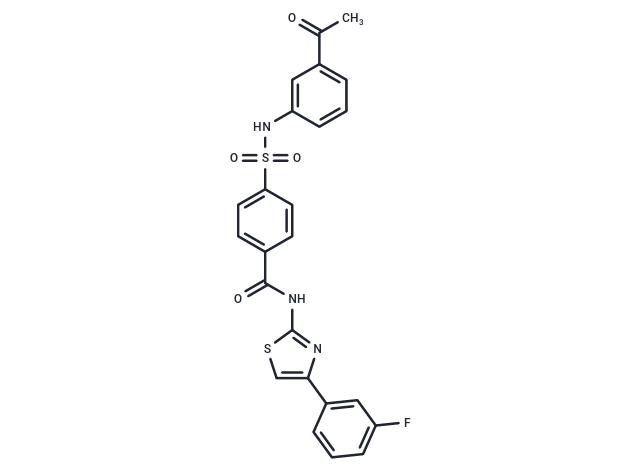Shopping Cart
Remove All Your shopping cart is currently empty
Your shopping cart is currently empty
PHGDH-IN-3 is an orally active phosphoglycerate dehydrogenase (PHGDH) inhibitor with an IC50 of 2.8 μM against PHGDH, and it can be used in cancer research.

| Pack Size | Price | USA Warehouse | Global Warehouse | Quantity |
|---|---|---|---|---|
| 1 mg | $98 | In Stock | In Stock | |
| 5 mg | $239 | In Stock | In Stock | |
| 10 mg | $355 | In Stock | In Stock | |
| 25 mg | $569 | In Stock | In Stock | |
| 50 mg | $762 | In Stock | In Stock | |
| 100 mg | $987 | In Stock | In Stock | |
| 500 mg | $1,980 | - | In Stock |
| Description | PHGDH-IN-3 is an orally active phosphoglycerate dehydrogenase (PHGDH) inhibitor with an IC50 of 2.8 μM against PHGDH, and it can be used in cancer research. |
| Targets&IC50 | PHGDH:2.8 μM, PHGDH:2.33 μM |
| In vitro | PHGDH-IN-3 (compound D8) exhibits strong enzymatic inhibitory activity with an IC50 value of 2.8 μM and demonstrates high binding affinity for PHGDH protein with a Kd value of 2.33 μM. It is particularly effective against cell lines with amplified or overexpressed PHGDH genes and restricts de novo serine synthesis from glucose in MDA-MB-468 cells.[1] |
| In vivo | PHGDH-IN-3 (compound D8) (1, 3 mg/kg; p.o., i.v.) exhibits excellent in vivo pharmacokinetic properties.[1] Additionally, PHGDH-IN-3 (12.5, 25, 50 mg/kg; i.p.; once daily for 31 days) demonstrated significant antitumor effects in a PC9 xenograft mouse model.[1] |
| Molecular Weight | 495.55 |
| Formula | C24H18FN3O4S2 |
| Cas No. | 2893778-31-7 |
| Smiles | N(C(=O)C1=CC=C(S(NC2=CC(C(C)=O)=CC=C2)(=O)=O)C=C1)C3=NC(=CS3)C4=CC(F)=CC=C4 |
| Storage | store at low temperature | Powder: -20°C for 3 years | In solvent: -80°C for 1 year | Shipping with blue ice/Shipping at ambient temperature. | |||||||||||||||||||||||||||||||||||
| Solubility Information | DMSO: 90 mg/mL (181.62 mM), Sonication and heating to 70℃ are recommended. | |||||||||||||||||||||||||||||||||||
| In Vivo Formulation | 10% DMSO+90% Corn Oil: 5 mg/mL (10.09 mM), Sonication is recommeded. Please add the solvents sequentially, clarifying the solution as much as possible before adding the next one. Dissolve by heating and/or sonication if necessary. Working solution is recommended to be prepared and used immediately. The formulation provided above is for reference purposes only. In vivo formulations may vary and should be modified based on specific experimental conditions. | |||||||||||||||||||||||||||||||||||
Solution Preparation Table | ||||||||||||||||||||||||||||||||||||
DMSO
| ||||||||||||||||||||||||||||||||||||
| Size | Quantity | Unit Price | Amount | Operation |
|---|

Copyright © 2015-2026 TargetMol Chemicals Inc. All Rights Reserved.